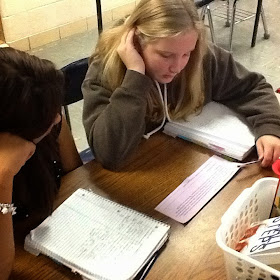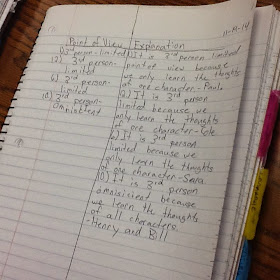To help students practice this this skill, I created 13 stations around the room. Each station had a short excerpt from a real text. I modeled the process at one of the stations so students knew exactly what to do and the expectations I had of their written responses. Students read the excerpt together, and through discussion, they had to determine:
1. What point of view is the excerpt written from?
2. How do you know?
Students referred to the chart in their Thoughtful Logs that had the information we had learned about the different points of view. This chart became a valuable resource for helping students defend their thinking.
After students orally discussed their answers, they recorded the point of view and an explanation of their thinking in their Thoughtful Logs.
Here is one student's Thoughtful Log. I modeled #1 and had students record it in their Thoughtful Logs so they had a sample written response to refer to no matter what station they were at. When students finished at one station, they looked around to see what other station was open and rotated to it whenever they were ready. You can see this student rotated from station #6 to #13 to #12 to #7.
You can see that this students also went to stations #12 and #6 and got the same answers as the previous student, despite them being in different partnerships. This process helped me identify which students needed more support and who was independent in the skill.
We have also been discussing the impact plot elements have on one another. Earlier in the month, we read a story about two boys named Carlos and Martino who went hiking on their own for the first time. Martino battled a man vs. self conflict, constantly doubting his abilities and worrying about what would happen with his parents not there. With this plot diagram, I changed the exposition to include the entire family going on the hike. (You'll notice I filled in the exposition with this changed information.) Students planned for the rest of the narrative using this plot diagram; they also had to pick a new conflict since the original man vs. self conflict was eliminated with Martino's family going on the hike together. By changing a plot element (the family hiking together rather than the two boys hiking alone as in the original version), the story had to take a different turn and put my students in charge.

After students planned their stories, they started their first drafts.
In a future lesson, I pointed out that great narratives have transitional phrases that help to move the story along. We read a mentor text called "The Party" and as I read, I had students record on the back of their planners all the transitional phrases they saw/heard and the paragraph where those phrases were found so we could easily locate and highlight them as a class after I read. Students then went back into their first drafts and revised their narratives to include transitional phrases.
In another lesson, I pointed out that great narratives also have specific nouns. We looked at the first draft of a "Carlos & Martino" story that I had written and on the left recorded the common nouns in my draft. On the right side, students helped me brainstorm specific nouns that I could use for each of my common nouns. I also encouraged students to use Google to find the names of specific nouns if they were unsure of ones themselves. Students then went into their own narratives to make their common nouns more specific!











What a great "station activity"! Do you do this all in one day or spread out over a few days?
ReplyDeleteThanks! It actually took 2 days. The first day I used a powerpoint to introduce each point of view and we looked at a few samples. On this first day we also constructed our anchor chart to anchor our learning. On the second day, we reviewed the anchor chart, I modeled how students should set up their thoughtful logs and how to respond to one of the stations, and then partners completed the stations. Most kids finished all the stations, but some didn't and that was ok. With about 10 minutes left in the second class period, I reviewed the correct answers for some of the stations, making sure to review each point of view. We didn't correct all the stations, as I didn't think that was necessary. Students made revisions to their answers if they needed to as we corrected. Since this was just practice, I wanted students to be able fix their misconceptions before I tested them later in the week!
ReplyDelete